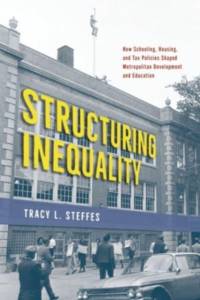Om Structuring Inequality
"As in many American cities, inequality in Chicago and its suburbs is mappable across its neighborhoods. Anyone driving west along Chicago Avenue from downtown can tell where Austin turns into Oak Park without looking at a map. These borders are not natural, of course; they are carefully maintained through policies like zoning and school districting; some neighborhoods even annex themselves into distinct municipalities. In other words, they are all policy decisions. In Structuring Inequality, historian Tracy Steffes explores how metropolitan inequality was structured, contested, and naturalized through public policy in the Chicagoland area, especially through public education and state government. This metropolitan inequality deepened even amid civil rights mobilizations and efforts to challenge racial discrimination and promote equal opportunity. She argues that educational and metropolitan inequality were mutually constitutive: unequal schools and unequal places cocreated and reinforced one another. School districts not only reflected the characteristics and inequalities between places, but they also played an active role in shaping those communities over time. Throughout the Chicago metropolitan area, school districts defined community in part by reinforcing or undermining racial and economic segregation. Their perceived quality shaped the identity and value of the community, and schooling and its costs could drive development decisions, including what kind of property to allow and residents to attract. Decisions about school construction, student assignment, and school support were often important components of development strategy. By denaturalizing policy to explore the choices that have brought us here and looking at efforts to challenge them, this history helps us understand the inequality we live with today and inspire us to change it"--
Visa mer

